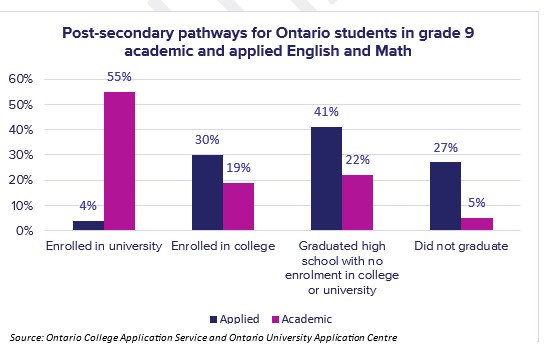Risky business: Choosing between school and apprenticeships may have unintended consequences
NEW! Update on consultation below
In March, the Ontario government announced a plan to allow grade 11 students to leave school to join full-time apprenticeship programs. The plan, if implemented, would make Ontario the only province or territory in Canada that would allow students to leave high school to enter apprenticeships full-time, rather than pursuing apprenticeships while still working towards their high school diploma.
While there is no doubt that improvements are needed so that more young people can envision and pursue careers in the skilled trades, a new analysis by People for Education raises numerous concerns.
Why not build on current skills and apprenticeship programs?
Currently, Ontario has multiple programs to support students in gaining job skills including the Ontario Youth Apprenticeship Program (OYAP), the Specialist High Skills Major (SHSM) program, cooperative education, as well as numerous dual-credit opportunities. These programs serve thousands of students across the province. Our analysis questions why the province is introducing a new, potentially stand-alone strategy disconnected from schools, rather than building on the current models that allow students to explore the skilled trades while still working towards their high school diploma.
Could the new plan exacerbate issues caused by streaming?
While Ontario has discontinued the policy of streaming students into either academic or applied courses in grade 9, students must still make that choice in grade 10. The evidence is unequivocal that streaming has a disproportionately negative impact on students who are Black, Indigenous, racialized, with disabilities, and/or from low-income households. Ontario data show that currently approximately one quarter of students in applied courses do not graduate, and less than one third go on to college.
People for Education is concerned that that the option to leave high school in grade 11 to pursue a full-time apprenticeship may lead to the same disproportionate outcomes of narrowing future pathways for students from historically marginalized groups.
How will the new policy address current issues in apprenticeship programs?
According to Statistics Canada, only 16% of apprentices obtain their apprenticeship certificates during expected the program duration. StatCan’s analysis found several barriers to completion, including gaps in knowledge and essential skills such as mathematics, a mismatch in expectations between employers and apprentices, and a lack of access, accommodations, support, and guidance to navigate the system. There is no information yet as to how Ontario’s proposed plan will address current structural issues in apprenticeships to ensure that it does not leave a higher number of young people at a dead-end with no apprenticeship certificate, high school diploma, or a way to get back into formal education.
How will students obtain key skills and competencies?
A high school diploma is a prerequisite for many well-paying jobs, including in the skilled trades. Extensive research, and the province’s own policy, point to the importance of the broad, transferable (sometimes referred to as “21st century”) skills gained in compulsory grade 11 and 12 courses. The province has proposed that young people could apply for an Ontario Secondary School Diploma upon completing their Certificate of Apprenticeship, however it is hard to know if these diplomas will be accepted as equivalent to the diplomas of students who completed all their compulsory high school credits.
What can we learn from other provinces and territories?
A scan of programs across the country reveals several promising practices to support students in pursuing a future in the skilled trades. B.C, Yukon, Saskatchewan, and New Brunswick have programs that create flexibility for students by providing things like financial support and waiving apprenticeship fees or allowing students to work full-time over the summer and part-time for the rest of the year while still attending high school.
Recommendations for next steps
Moving forward, People for Education recommends keys steps for the Government of Ontario and the Ministry of Education before implementation of the new apprenticeship program:
- Provide ample opportunities and resources for parents, students, teachers – especially guidance and career counsellors – to learn about the trades as early as in grades 7 and 8.
- Address the existing challenges faced during apprenticeships and school programming related to the skilled trades (i.e., OYAP, SHSM program, etc.).
- Support the ongoing implementation of de-streaming by providing the necessary resources to schools (e.g., professional development, consultations regarding implementation, clear communication about curriculum changes, and funding for lower class sizes and guidance counsellors), and develop an adequately resourced plan for the de-streaming of grades 10, 11, and 12.
- Publicly collect and report identity-based data on student pathways and outcomes to monitor how policies and programs are impacting different groups.
- Convene an Education Task Force to provide advice on this and other interrelated education issues. The Task Force should include, but not be limited to, teachers, principals, support staff, students, directors of education, school board trustees, employers, representatives from the skilled trades, apprenticeship program delivery experts, colleges and universities, and Indigenous leaders.
UPDATE ON CONSULTATIONS
Ontario’s Ministry of Education has launched consultations on its plan to allow students to enter apprenticeships full time starting in grade 11.
There are two models being proposed for consideration. Both involve full-time apprenticeships for students who are at least 16 years old and have at least 16 high school credits:
Model #1: Equivalent Apprenticeship Learning:
- In this model, students remain a student of their school board while pursuing apprenticeship learning full time. These students would be partially funded as secondary students but would be excused from attending school.
- There is no expectation that students be in school during instructional days.
- Check-ins with school staff (e.g. teacher, Student Success Teacher, Student Success Lead, OYAP Recruiter, provincial attendance counsellor or other primary contact) would take place on a regular basis.
- All credits toward earning their Ontario Secondary School Diploma would be earned through students’ hands-on apprenticeship experience.
- New courses or assignments could be developed in this model that might involve “traditional classroom learning either remotely, in night school or summer school.”
- Students would have continued access to school board services and supports (e.g.,
- guidance services, Student Success teacher/team).
- Students could participate in school-based activities and groups (e.g., school sports, student council, student-led groups) so long as these activities were not in conflict with the student’s apprenticeship schedule.
Model #2: Employer Supervised Apprenticeship:
- The apprentice would no longer be a student of the school board and would be excused from attendance at school while pursuing apprenticeship learning full time.
- In this model, participants would no longer be considered as students and would not have access to school board services and supports.
- Upon completion of a Certificate of Apprenticeship, the young person, when eligible could choose to go through a Prior Learning Assessment and Recognition for Mature Students process at a school board to earn/receive their OSSD.
The consultation guide states that the proposed models have two objectives:
- Improve access into the skilled trades: Create more opportunities for students to pursue a career in the skilled trades.
- Address labour market supply challenges: Enable more students to enter the skilled trades faster and bolster Ontario’s skilled trades workforce.
Consultation also underway at Ministry of Labour, Immigration, Training and Skills Development
According to the consultation guide, this consultation is connected to a separate consultation being led by the Ministry of Labour, Immigration, Training and Skills Development that is exploring lowering the Academic Entry Requirements for apprenticeship registration for trades which is currently set at a Grade 12 level.
No consultation on how to make existing programs more effective
The consultation guide explicitly states that the Ministry of Education is not consulting on existing programs such as Specialist High Skills Majors, the Ontario Youth Apprenticeship Program or Dual Credit Apprenticeship training. Nor does there appear to be any consultation connected to examining effective apprenticeship models in other provinces and territories and/or other countries. Other models allow students to stay in school and enrolled in core courses while pursuing apprenticeships part time.
Deadline for feedback
The deadline for feedback is 5:00pm on November 24, 2023. Use this link to provide feedback or send comments by email to [email protected]
